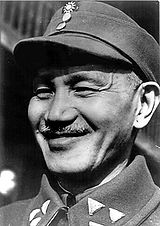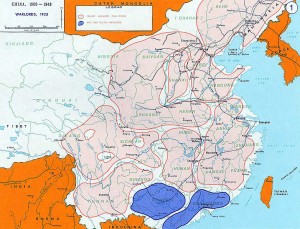History of the PRC – Part Seven Posted by sasha on Nov 24, 2010 in Uncategorized
With the passing of Sun Yat-sen, peace talks in Beijing completely fell apart. As for Sun’s party, the KMT, there would of course have to be a changing of the guard. Wang Jingwei would control the left wing of the party, while Hu Hanmin would head the right wing. However, complete control lay with Chiang Kai-shek, who basically controlled the military as he was in charge of the Whampoa Military Academy. Setting up in Guangzhou, the Nationalists had a rival government to oppose the warlord government up north in Beijing.
Speaking of the north, conflict was again brewing within the Beiyang government powers. Fengtian General Guo Songling (郭松龄) defected to the Nationalist Army (国民军), or KMC. This sparked yet another bloody civil war – the Anti-Fengtian War (反奉战争 – Fǎn fèng zhàn zhēng). Lasting from November 1925 to April 1926, the war pitted the KMC against the combined forces of the Fengtian and Zhili cliques. Still harboring resentment towards Feng Yuxiang for the coup he organized in Beijing, Wu Peifu set aside his differences with Zhang Zuolin and his Fengtian group to fight against the KMC.
Back down south, Chiang was trying to woo Sun Chuanfang (孙传芳) of the Zhili clique to defect to the KMT. Sun refused to join, and he had some of Chiang’s emissaries executed, which led to Chiang exeucting Sun’s envoys. As you can see, this was a brutal and violent period in China’s history.
In the early stages of the war, the KMC was successful in their attack on Zhang’s forces. However, their success wouldn’t last long, as Japanese forces were supporting Zhang. On Christmas Eve in 1925, Guo was killed in Shenyang (沈阳), and the KMC began losing soldiers at an alarming rate. Many were killed in battle, while countless others abandoned ship and gave up on the cause. It was so bad for the KMC that Feng resigned as a warlord and moved to the Soviet Union.
During one attack by Japense forces on the KMC, many civilians were kiled. This led to protests in Beijing calling for an end to all of the unequal treaties signed between China and other countries. Protestors marched to the headquarters of the Beiynag government, which worried Duan Qirui. He ordered police to clear the crowd, which, not surprisingly, led to violence. Many were killed and even more were injured in the melee. A few weeks later, Duan would be removed from office by KMC forces.
Perhaps feeling defeated, the KMC decided to release ex-President Cao Kun. Fengtian and Zhili forces would chase the KMC out of the capital, and then the internal fighting began. Wu wanted to give the presidency back to Cao, while Zhang hoped to restore the last Emperor, Pu-yi. Eventually, Zhang would declare himself the Grand Marshal of the Republic of China. Back in Guangzhou, however, Chiang and the KMT had different ideas.
Although Chiang was skeptical of his predecessor’s policy of alliance with the Sovietys, he still relied on aid from them. The National Revolutionary Army (国民革命军 – Guó mín gé mìng jūn) was founded and the joint KMT/CCP forces were ready to destroy warlord China. First, they would take out Wu, then Sun, and finally Zhang, in what would come to be known as the Northern Expedition (北伐 – Běi fá). In Part Eight of this intense history lesson, we’ll examine the Northern Expedition in detail and move one step closer to modern day China!

Build vocabulary, practice pronunciation, and more with Transparent Language Online. Available anytime, anywhere, on any device.
About the Author: sasha
Sasha is an English teacher, writer, photographer, and videographer from the great state of Michigan. Upon graduating from Michigan State University, he moved to China and spent 5+ years living, working, studying, and traveling there. He also studied Indonesian Language & Culture in Bali for a year. He and his wife run the travel blog Grateful Gypsies, and they're currently trying the digital nomad lifestyle across Latin America.






Leave a comment: